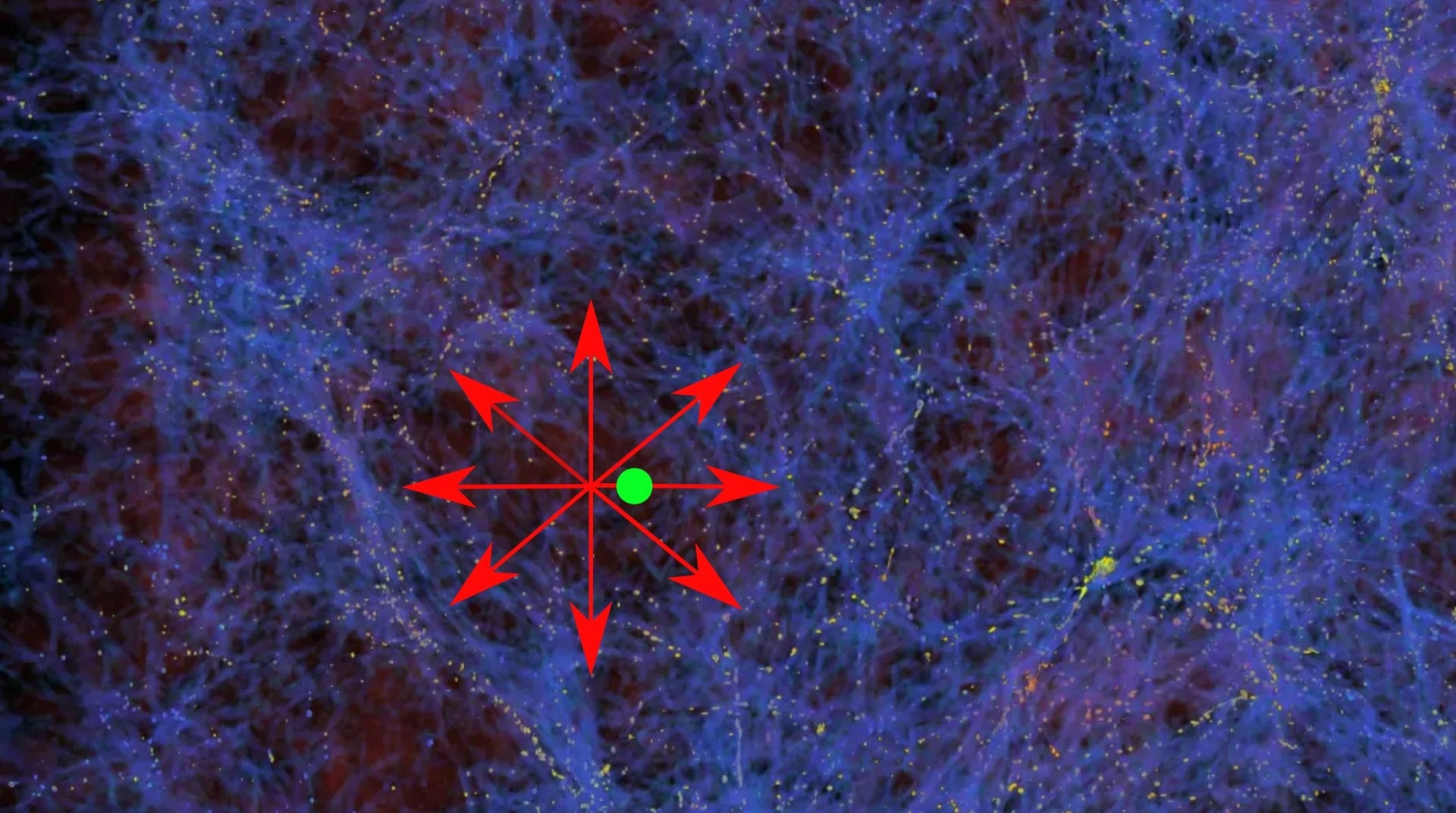The universe undergoes expansion, and the rate of this expansion is characterized by the Hubble-Lemaitre constant. However, controversy surrounds the actual magnitude of this constant, as different measurement techniques yield conflicting values. This discrepancy, known as the “Hubble tension,” presents a perplexing challenge for cosmologists.

The image shows the distribution of matter in space - (blue; the yellow dots represent individual galaxies). The Milky Way (green) lies in an area with little matter. The galaxies in the bubble move in the direction of the higher matter densities (red arrows). The universe therefore appears to be expanding faster inside the bubble. Image Credit: AG Kroupa/University of Bonn
Researchers from the Universities of Bonn and St. Andrews propose a novel solution to this dilemma.
They suggest that by employing an alternative theory of gravity, the disparity in measured values can be easily accounted for, leading to the disappearance of the Hubble tension. The findings of this study are now available in the Monthly Notices of the Royal Astronomical Society (MNRAS).
As the universe expands, galaxies move apart from each other, and the rate of this movement is directly proportional to the distance between them. For example, if galaxy A is twice as far away from Earth as galaxy B, its separation from us increases at a rate twice as fast. This correlation was first recognized by the US Astronomer Edwin Hubble.
To calculate the velocity at which two galaxies are receding from each other, knowing their distance is crucial. However, determining this distance requires multiplication by a constant—the Hubble-Lemaitre constant, a fundamental parameter in cosmology.
Its value can be derived by examining the extremely distant regions of the universe, providing a speed of nearly 244,000 km per hour per megaparsec distance (where one megaparsec is slightly over three million light-years).
244.000 kilometers Per Hour per Megaparsec-or 264,000?
But you can also look at celestial bodies that are much closer to us - so-called category 1a supernovae, which are a certain type of exploding star.
Dr. Pavel Kroupa, Professor, Helmholtz Institute of Radiation and Nuclear Physics, University of Bonn
Precisely determining the distance of a Type 1a supernova from Earth is achievable. Additionally, researchers are aware that luminous objects alter their color when in motion, and the intensity of this change is proportional to their speed. This phenomenon is akin to an ambulance, whose siren produces a lower pitch as it moves away from an observer.
By calculating the speed of Type 1a supernovae based on their color shift and establishing a correlation with their distance, a distinct value for the Hubble-Lemaitre constant emerges. Specifically, this value is slightly below 264,000 km per hour per megaparsec distance.
The universe therefore appears to be expanding faster in our vicinity - that is, up to a distance of around three billion light years - than in its entirety. And that shouldn’t really be the case.
Dr. Pavel Kroupa, Professor, Helmholtz Institute of Radiation and Nuclear Physics, University of Bonn
However, a recent observation may offer an explanation for this phenomenon. According to this observation, Earth is situated in a space region characterized by a relatively low concentration of matter, akin to an air bubble within a cake. The matter density is higher in the vicinity surrounding the bubble.
Gravitational forces emanate from this surrounding matter, exerting a pull on the galaxies within the bubble, causing them to move towards the edges of the cavity.
“That’s why they are moving away from us faster than would actually be expected,” explained Dr. Indranil Banik from St. Andrews University.
The discrepancies could thus be easily accounted for by a localized “under-density.” In fact, another team of researchers recently gauged the average velocity of a substantial number of galaxies situated 600 million light years distant from us.
“It was found that these galaxies are moving away from us four times faster than the standard model of cosmology allows,” explains Sergij Mazurenko from Kroupa’s research group, who was involved in the current study.
Bubble in the Dough of the Universe
This arises because the standard model does not incorporate the concept of under-densities or “bubbles”— according to the model, they should not exist. Instead, the standard assumption is that matter should be uniformly distributed in space. However, if this were the actual scenario, it would pose a challenge in elucidating the forces responsible for propelling galaxies to their high speeds.
The standard model is based on a theory of the nature of gravity put forward by Albert Einstein. However, the gravitational forces may behave differently than Einstein expected.
Dr. Pavel Kroupa, Professor, Helmholtz Institute of Radiation and Nuclear Physics, University of Bonn
The research teams from the Universities of Bonn and St. Andrews employed a computer simulation utilizing a revised theory of gravity. This theory, known as “modified Newtonian dynamics” (abbreviated as MOND), was introduced four decades ago by the Israeli Physicist Prof. Dr Mordehai Milgrom. Despite its four-decade existence, MOND is still regarded as an unconventional or outsider theory in contemporary scientific discourse.
Kroupa stated, “In our calculations, however, MOND does accurately predict the existence of such bubbles.”
If one should consider the possibility that gravity adheres to Milgrom's postulates, the Hubble tension would vanish. In this scenario, there would exist only a single constant governing the expansion of the universe, and any observed deviations would be attributable to irregularities in the distribution of matter.
Apart from the University of Bonn, the study involved collaboration with the University of Saint Andrews in Scotland and Charles University in Prague, Czech Republic. This study was financially supported by the British Science and Technology Facilities Council.
Journal Reference
Mazurenko, S., et al. (2023) A simultaneous solution to the Hubble tension and observed bulk flow within 250 h−1 Mpc. Monthly Notices of the Royal Astronomical Society. doi.org/10.1093/mnras/stad3357.